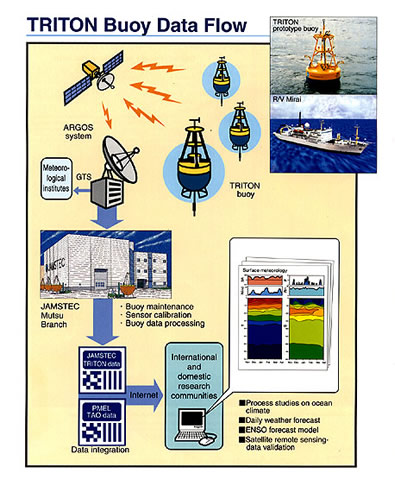TRITON data distribution
The 10- minute data are averaged for 1 hour and transmitted ashore from TRITON buoys via the ARGOS system. The real time data are distributed by the GTS (Global Telecommunication System) from the French ARGOS global processing center to be used by the meteorological agencies and institutions for ENSO monitoring, daily weather forecasts, and so on. When the data come into the Mutsu Institute of JAMSTEC, the quality is checked daily, and the validated data are sent to PMEL. This procedure is carried out with the comprehensive TRITON Data Management System software. After receiving the TRITON data, PMEL integrates them with TAO data, and creates common format gridded data. Then, JAMSTEC and PMEL distribute the data from their web sites (Fig. 1 ) .

Figure 1 TRITON buoy data flow.
ARGOS data transmission
Transferring TRITON real time data via ARGOS is carried out as follows. The data processor unit provides hourly averaged data to the ARGOS transmitter unit as a 200-byte packet of ASCII characters. In one day, 4.8 K-bytes of data (200 bytes x 24) need to be transmitted. The ARGOS transmitter unit is designed to achieve a nearly 100% data recovery rate, retaining real time data availability. The ARGOS transmitter unit first converts the ASCII format data from the data processor unit into binary format. This reduces the 200 bytes of data to about 70 bytes. The challenge is to transfer all of these 70 bytes of hourly data using the 32-byte-format ARGOS messages. Most of the TRITON buoys are deployed in low latitude areas, where the number of satellite passes is small. The ARGOS transmitter unit creates 5 ARGOS messages from 2 hourly data sets (70 bytes x 2), then composes a packet of the last 12 hours' data, which consists of 30 ARGOS messages. The messages are transmitted one after another with a short repetitive period. This takes 10 minutes. After one cycle of this transmission, the same 30 messages are transmitted repeatedly until new hourly data arrive from the data processor unit. The ARGOS transmitter unit then recomposes a new set of 30 messages to be used in the next one hour. In this way, each ARGOS message is transmitted to a satellite at least once in a pass except for very low elevation passes, since most satellite passes last more than 10 minutes. This means that all new data are likely to be received in the first satellite pass, which contributes to real time data availability. Furthermore, since all hourly data are transmitted for 12 hours, each ARGOS message is transmitted to the satellites more than 3 times, even with a minimum constellation of two satellites. This assures a high probability of recovery. Since the deployment of the buoys in February and March 1999, no data have been lost due to transmission error. The data recovery rate was 100% in the first half-year. Each ARGOS message was received error-free more than 7 times on average.
